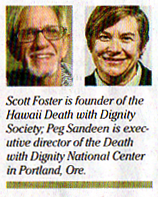
March 9, 2017
Editorial| Island Voices
The right to choose death provides peace of mind and relief
By Scott Foster and Peg Sandeen

For those who do decide that the suffering and pain has simply stripped them of a meaningful life, providing this end-of-life option allows them to leave this world in peace, surrounded by their loved ones and friends including the pets they leave behind.
Twenty years ago, the nation’s first Death with Dignity law went into effect in Oregon.
Since then, implementation of the law has been flawless. Not a single instance of coercion, failure, targeting, insurance scam or any of the fears expressed by opponents has come to pass. In other states where the law has been implemented, the results are very similar.
Yet in recent op-eds, opponents continue to make the same claims — claims that have not and will not materialize under the proposed Hawaii Death with Dignity Act.
Who determines death? Some argue it’s simply God’s will. Whether by injury, accident, old age or some horrible disease, they claim only God can make that decision as to when we are to leave this world. Yet we know it is far more complex than that. Debilitating, horrible conditions like cancer or ALS, the two most common underlying diseases for people who use the Oregon law, leave dying patients suffering at the end of their life. This law gives them a chance to control those final days by allowing them to go through a lengthy, controlled and well-documented process to obtain and self-administer medication to end their life.
We also know that those who don’t support this view of patient choice should not have to participate. The opt-out provisions for medical professionals clearly allow them to make a decision not to participate. And that’s the way it should be.
In Oregon, the law is used rarely. In 2016, 133 people used the Death with Dignity Act to hasten their death — fewer than 4 in 1,000 of all deaths in the state. Demographic data show people receiving the medication are over 70 years old and in hospice care. Nine in ten die at home.
Washington, Vermont, California, and, most recently, Colorado and Washington, D.C., have all used the same framework as Oregon to determine when a terminally ill person can seek this end of life option: when they are mentally competent and within six months of death.
The safeguards in all Death with Dignity laws include: repeated written and oral requests by the patient; the patient must be diagnosed by two doctors with a terminal illness within six months of death (the same standard as hospice); if depression is indicated, there is a mandatory psychiatric screening; all health care professionals can opt out; and the patient is required to self-administer the medication.
Talk to family members of people who have used the law and they will tell you that their loved one made one affirmative choice after another. At each step of the process, there is an off-ramp for that patient; all they have to do is say “Stop.” In fact, 1 in 3 patients who obtain a prescription never uses it. But the sense of peace and control they receive from knowing they are in control of those final days provides incredible peace and relief. Just knowing they have control is all they need to leave us peacefully.
These well-vetted provisions have worked, despite the misgivings of opponents. Health care professionals have been able to operate as their conscience or religion dictates, opting out or participating as they see fit.
And as for the patients — they and no one else determine the manner and time of their death.
This choice may not be right for all. No one is forced or obligated to use this voluntary option. But for those who do decide that the suffering and pain has simply stripped them of a meaningful life, providing this end-of-life option allows them to leave this world in peace, surrounded by their loved ones and friends including the pets they leave behind.
Scott Foster is founder of the Hawaii Death with Dignity Society; Peg Sandeen is executive director of the Death with Dignity National Center in Portland, Ore.
Original (behind pay wall) HERE
-###-
